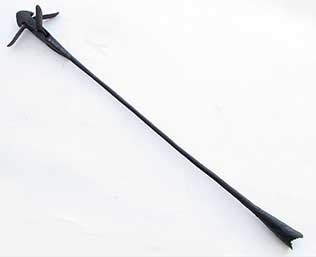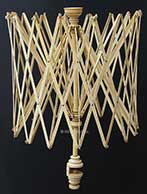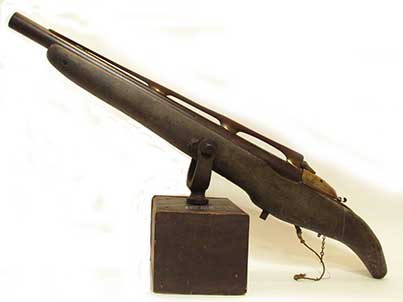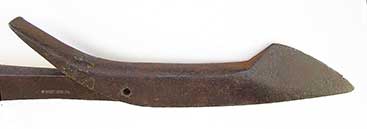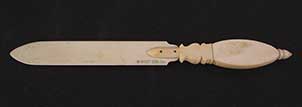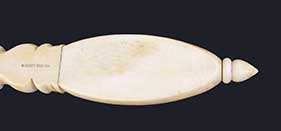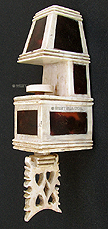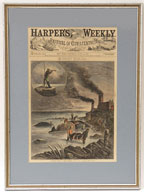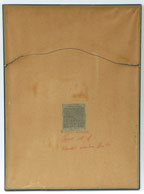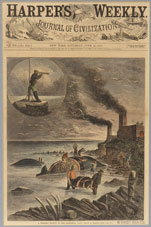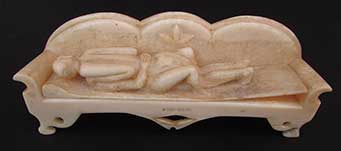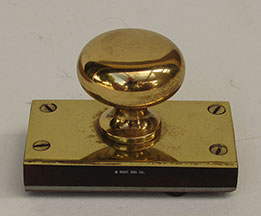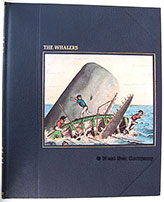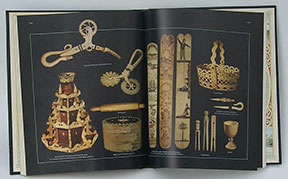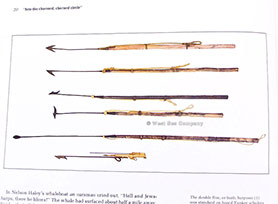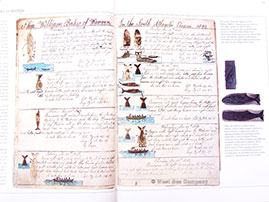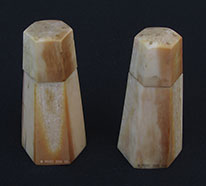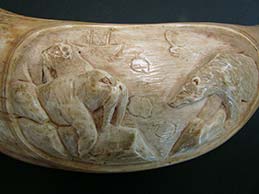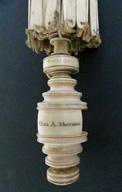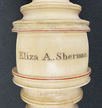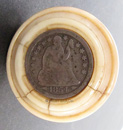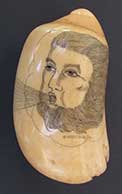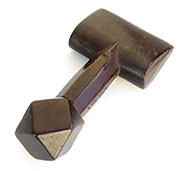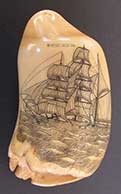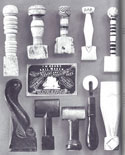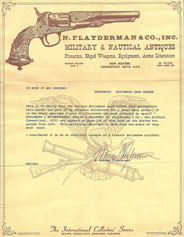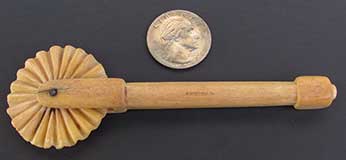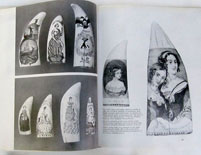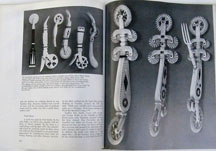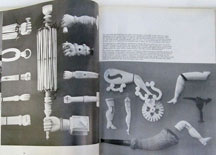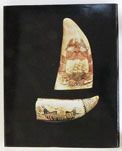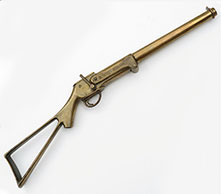SCRIMSHAW & WHALING
Catalog Page 4
When no price is shown, use
Click on photos for larger images.
Click
![]() for ordering details.
for ordering details.
NOTE: A recent California statute makes it illegal in that state to "possess with the intent to sell" many forms of srimshaw, elephant ivory and other endangered species products, without regard to the age of the object. The exception to this is walrus. Accordingly, the items listed below are not available to California residents. However West Sea Company still maintains its long-time affiliate in the state of Massachusetts where these antique items are currently stored and sold legally.
 |
|
4.03 HISTORICAL WHALING REFERENCES. Cased, two volume set of the comprehensive research compiled by Alexander Starbuck, first published as “Part IV of the Report of the U.S. Commission On Fish and Fisheries, Washington” in 1878. This handsome hard bound cloth cover edition in slip case was published in 1964 by Argosy Antiquarian Ltd. and printed by Sentry Press, New York, limited to 750 copies. To those familiar with this exhaustive work documenting whaling voyages out of American ports from 1784 – 1876, no introduction is necessary. It is literally the “bible” of American whaling. The first 179 pages comprise a detailed narrative of the history of the American whale fishery. That is followed by an accurate listing of every whaling vessel to set sail from American shores in the period covered. The information contained includes the year, home port, vessel name, class/type, captain, managing owner or agent, whaling ground, dates of sailing and of return, the results of the voyage in terms of quantities of sperm oil, whale oil and “whalebone” (baleen), and remarks. A most valuable asset in virtually mint, untouched condition. This set would make a prized gift to the scrimshaw collector and/or whale enthusiast. 150 |
|
VOLUMES
|
PAGE
|
PAGE DETAIL
|
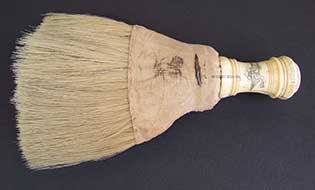 |
|
4.99 HARPOON REFERENCE BOOK. Thomas Lytle, “Harpoons and Other Whale Craft,” 1984, Old Dartmouth Historical Society, New Bedford, Massachusetts, second edition 2005. Hard cloth cover, 250 pages exclusive of index. Without question, Mr. Lytle has compiled the “bible of whaling implements” in this book, with a comprehensive study of the history of whalecraft and the many ingenious forms into which it finally evolved. Included are detailed descriptions, photographs, line drawings, period advertisements and patent material about harpoons, harpoon guns, bombs, trying out utensils and the many variations thereof. Appendix A contains biographical sketches of the noted makers of whalecraft in American. Appendix B is a photographic catalog with descriptions of the extensive collection of whalecraft in the New Bedford Whaling Museum. Soon after the first edition was published the Kendall Whaling museum merged with the New Bedford Museum. The benefit of this 2005 edition is that it contains updated information on the collection as expanded by the Kendall additions. As new condition. 149 |
|
PLATE 1
|
PLATE 2
|
|
4.01 ANTIQUARIAN WHALING
BOOK. William M. Davis, “Nimrod of the
Sea or, The America Whaleman,” 1874, Harper &
Brothers Publishers, New York. Hard cloth cover, 395
pages exclusive of 4 appendices. Written at the tail
end of the golden age of whaling, this narrative was done
from the perspective of an actual whaleman and comprises his
observations of the whaleship, shipboard life, the rewards
and perils of whaling, foreign ports, and the experiences
unique to sailor on a long and dangerous voyage to the 4
corners of the earth. Nicely illustrated with 30 wood
block engravings. Some interesting penciled notations
with dates on the end papers by an early owner. 5
¼ by 7 ½ inches. Excellent, well preserved
condition with only light toning to the pages from
age. Contemporary heavy plastic protective cover.
Rare, particularly in such fine condition.
|
|
PLATE 1
|
PLATE 2
|
|
4.02 WHALEBOAT BOOK.
Erik A. R. Ronnberg, Jr., “To Build A
Whaleboat,” 1985, The New Bedford Whaling Museum, New
Bedford, Massachusetts. Hard cloth cover with dust
jacket, 150 pages, large format 11 ½ by 9 inches, with
a detailed fold-out diagram of a classic American
whaleboat. This book details step-by-step instructions
on how to build a scale model of an early American
whaleboat. To those ends, the author begins with the
history of building such boats, then transitions into
meticulous instructions accompanied by copious black and
white photographs and line drawings. A great
reference, if only for the sake of the details and
specifications. Very good condition. |
|
PLATE
|
FOLD OUT
|
|
4.76 SCRIMSHAW WHISTLE. Miniature 19th century whistle turned and carved from solid bone with a wooden plug insert enclosing a bone capture ball. The bulbous body of the whistle terminates in a long, decoratively turned handle. Overall it measures 2 3/8 inches long and 7/8ths inches wide. Excellent original condition. This whistle produces a very high pitched, inconsistent modulated tone when blown, as actuated be the ivory capture ball contained within. 149 |
|
SIDE
|
BOTTOM
|
|
4.98 PICK WICK WITH PROVENANCE.
Mid-19th century or earlier scrimshaw oil lamp tool
made by an American whaleman. This lovely yet
functional devise is turned from two solid pieces of whale
tooth ivory. The bottom forms the supporting pedestal
which is fashioned using the classic cup and urn design from
Greek times. It is beautifully scribed with delicate
lines embellished with red and green polychromed
highlights. The working end of this pick wick consists
of a delicately-turned whale ivory knob with iron shaft and
pointed end which was used to advance the wick in early
whale oil lamps before the advent of built-in devices for
that purpose. This rare surviving example measures 3
¼ inches tall overall and 1 5/8 inches in diameter on
the base. The pick wick itself is 2 ¼ inches long
overall. Excellent original condition showing
good signs of actual use but no abuse. A most
desirable scrimshaw object with a fine pedigree.
495 Prior to the advent of the wick advance knob, which was patented during the Civil War, wicks in oil lamps required manual advancing using a pick wick as they burned down. Accordingly this example dates from the American Civil War era or earlier. |
|
REVERSE
|
PICK
|
LABEL
|
|
4.97 SCRIMSHAW WHISTLE. Miniature 19th century whistle turned and carved from a solid piece of dense whalebone with a wooden plug enclosing a bone capture ball. The bulbous body of the whistle terminates in a spherical turned bone handle through which a cord could be rove for hanging around the neck. Overall it measures 2 1/4 inches long and 1 inch wide. Excellent original condition. This whistle produces a very high pitched, strong tone when blown, nicely modulated by the capture ball within. 195 |
|
4.62 SCRIMSHAW SPOON. Genuine, mid-19th century sailor scrimshaw in the form of a large, functional serving spoon. This finely crafted utensil is hand-carved from a large single solid piece of dense whalebone. Attesting to its functionality and use, the working end exhibits roughness and wear, while the handle has a smooth almost polished appearance from handling. 12 ¾ inches long by 1 ¾ inches wide at the widest and generally 3/8ths inch thick. Excellent original condition showing good honest use and a nice age patina. A scarce example of utilitarian scrimshaw. 369 Not available or for sale in California. Shipped from Massachusetts. |
|
4.87 ANTIQUE SCRIMSHAW. Genuine 19th century scrimshaw on a large whale’s tooth depicting a full-rigged ship at sea. The vessel is shown flying the British Naval ensign with its gun ports in evidence. Nearly half of the ship’s sails are shown deployed, with the remainder reefed. The ship is portrayed as plying a placed sea which encompasses the entire tooth. The engraving is deeply incised as is typical of 19th century British scrimshaw. This tooth measures 5 ¼ inches tall by a goodly 3 inches wide. The root interior of the tooth bears an indistinct inscription which may read “July 1879.” A righteously early scrimshawed tooth with surprisingly NO age cracks! 989 |
|
4.84 SCRIMSHAW NEEDLE CASE. Genuine late 19th century scrimshaw needle case of diminutive size made out of the dense bone from a sperm whale’s jaw. This commercially produced item is a good example of the industrial output resulting from the American whale fishery in the 1800’s. It consists of a finely turned shaft with bulbous ends and a hollow core. Remarkably it is finely threaded in the center opening into two parts which are designed to hold a sharp sewing needle safely. Only 2 ½ inches long and in perfect condition. A rarity, very reasonably priced! 59 |
|
4.83 SAILOR’s PERSONAL
SCRIMSHAW. Small sailor-made personal
hygiene device tool as carried by sailors in the 19th
century. This handy pocket tool consists of a
hand-carved whalebone device with multi-functions. The
body terminates on one end as a pointed shaped scoop
suitable for cleaning the ears or fingernails. The
reverse end is pinned, holding three sharp tapered tines
suitable for a variety of uses such as picking the teeth,
scraping the nails, punching holes in clothing, etc.
Cleverly, the body of the implement is shaped in such a way
that and indentation allows one’s fingernail to expose
the tines. Excellent original condition, remarkable in
the fact that the delicate sharp tips are still in
tact. One side is faintly marked “MAGEE.”
2 inches long. A classic 1800’s sailor
object.
89 |
|
4.76 SCRIMSHAW WHISTLE. Miniature 19th century whistle turned and carved from a solid piece of dense whalebone with a wooden plug insert enclosing a bone capture ball. The bulbous body of the whistle terminates in a long, decoratively turned handle. Overall it measures 2 3/8 inches long and 7/8ths inches wide. Excellent original condition. This whistle produces a very high pitched, inconsistent modulated tone when blown, as actuated by the ivory capture ball contained within. 149 |
|
4.75 SCRIMSHAW DIPPER.
Exquisite mid-1800s American whaleman-made dipper used to
apportion a sailor’s ration of grog or water.
This splendid piece of functional shipboard scrimshaw
consists of a coconut shell bowl fitted to a whale ivory
connector using copper rivets. The bowl is carved
around the rim with a single scribe which provides a smooth
lip. The connector, in the shape of a heart, attaches to the
sculpted rich mahogany handle which terminates in a
beautifully carved fist made of whale tooth ivory holding a
suspension loop. The anatomically perfect fist is even
depicted with fingernails on each finger! It has a
distinctive cuff inlaid with 3 mother-of-pearl buttons and
is connected to the handle with a baleen separator. An
ivory suspension loop, reinforced with a brass rod is
contained within the grasp of the fist. The quality
and condition of this dipper defy elaboration. Signs
of actual use and staining are on the inside of the bowl.
14 inches long and 3 ¾ inches wide on the bowl.
Perfect condition. It is museum quality and
worthy of the finest collection -- certainly one of
the finest examples of its type ever! Not available or for sale in California. Shipped from Massachusetts. |
|
4.72 SCRIMSHAW TOOL. Genuine 19th century American auger or threading tap, hand-made with a whalebone handle. This handsome, decorative, yet very functional tool is boldly marked with the maker’s initials “W R.” It is 4 inches long and 3 inches wide on the handle. Outstanding original condition. 395 ex. Paul Madden Antiques, with original label and still priced at the original selling price 30 years ago! Not available or for sale in California. Shipped from Massachusetts. |
|
4.58 WHALEBONE MARKING DEVICE. Authentic old sailor’s tool from the age of sail, carved entirely from a single piece of the dense bone from a sperm whale’s jaw. This simple yet clever tool was designed to lay out pre-set distances on sail cloth for sewing. To those ends there are a variety of stepped edges with various widths carved into the ends of the tool for the sail maker to choose from. 5 3/5 inches long, 1 1/8 inches wide and 5/8 inches thick. Excellent original condition exhibiting a rich deep age patina showing much use but no abuse. 389 Not available or for sale in California. Shipped from Massachusetts. |
|
4.90 SCRIMSHAW REFERENCE BOOK. Edouard A. Stackpole, "Scrimshaw At Mystic Seaport," 1958, Second printing 1966, The Marine Historical Association, Incorporated, Mystic, Connecticut, 53 pages, hard cloth cover with dust jacket. Written in 1955, Everett Crosby's landmark book, "Susan's Teeth and Much About Scrimshaw" was the first book ever published on the topic of scrimshaw. The book offered here was published just 3 years later as a more scholarly and comprehensive "introduction to scrimshaw." Accordingly, the book's introduction is well worth quoting: "A century ago the American whale fishery, the most extensive and lucrative in world history, was just past its peak. As a theme for adventure in industry, whaling had few peers. As a nursery for seamen it was unrivaled. By the same token it was one of the hardest and most brutal seafaring activities the world has ever known. The whalemen of New England established a record for daring and enterprise that was never equaled. At first whales were taken near shore. In 1716, Capt. Christopher Hussey of Nantucket, sighted and killed a sperm whale at sea off that island, thus beginning one of the most exciting chapters in American Maritime history which culminated in voyages around the world sometime lasting 4 and 5 years! It was during those long arduous, but often monotonous trips that scrimshaw gave creative relief to the sailors. It is against this backdrop that the marvelous creations contained within these chapters are presented." Excellent original condition. Ex. Libris. 14 |
|
4.96 REFERENCE BOOK, “The WHALERS.” Certainly our favorite amongst all of the wonderful, awarding winning Time-Life series books The Seafarers, authored by noted maritime historian, A.B.C. Wipple, and published by Time, Inc., Alexandria, Virginia in 1979. This book chronicles one of the most dangerous and exciting pursuits in American maritime history. It opens with the primitive whale fishery begun when America was a struggling colony and ends in the waning days of whaling when America had advanced to preeminence as the world’s leading industrial nation. The intervening years were dominated by the remarkable struggle between man and the largest beast on earth, played out thousands of times. It yielded oil for the nation’s lamps and raw materials for its manufacturing. Every aspect of that industry, both at sea and ashore is covered here. The lives of the men, their ships, wives, and their ports of call -- all make for fascinating reading. Then there was that most amazing by-product of the whaling industry SCRIMSHAW! Beautifully illustrated in color and black white, with original paintings, drawings, diagrams, photographs and more! Hard faux leather cover, 173 pages exclusive of index. Unused condition. 69 |
|
4.54 SCRIMSHAW LETTER OPENER. Genuine mid-19th century American whaleman-made utilitarian scrimshaw in the form of a rarely found letter opener. This unique example is constructed entirely of the dense panbone of a sperm whale’s jaw. The long thin blade is slightly thicker down the middle, tapering to a fine edge on both sides. It is attached to the handle with a perfect mortised fit using two silver rivets to hold it in place. The joint is decoratively-rounded with a carved ridge at the base of the handle. This letter opener measures 9 ¼ inches long overall. The blade is 5 ¾ inches and the handle is 5 inches (accounting for the joint). Outstanding original condition with a nice age patina indicative of its 150+ years. 329 Not available or for sale in California. Shipped from Massachusetts. |
|
4.51 SCRIMSHAW BOWIE KNIFE/CRIBBAGE BOARD. Truly exceptional Eskimo knife fashioned entirely out of a walrus tusk ivory. This incredible example of native North American ethnic art was made by a master artisan with superb skills. The long thin (about 1/16th inch) blade is made of a single solid piece of walrus tusk 10 inches long. Once side is engraved (scrimshawed) with a dog team pulling a sled with an Eskimo mushing. The reverse of the blade is engraved with the most delicate floral pattern in the form of lovely leaves. The blade is mortised into a solid walrus tusk handle secured with two ivory pins. A stout hilt separates the two. The unique handle is decorated with an image of a stalking arctic weasel while the reverse is an amazingly precise cribbage board decorated with recurring leaf patterns. Circa 1920. 14 3/8 inches long overall by 3 inches wide on the hilt. Absolutely perfect original condition with a mellow age patina. 1895 In Dorothy Jean Ray’s monumental and ground breaking work “Eskimo Art, Tradition and Innovation in North Alaska” 1977, Henry Art Gallery, Seattle, no examples are depicted which even approach the quality or construction of this rare example. A genuine a museum piece in every respect! Ex. Sotheby’s Parke Bernet |
|
4.45 SCRIMSHAW LETTER OPENER. Particularly fine 19th century whaleman-made letter opener fashioned entirely of whale tooth with inlays of silver and abalone! This rarely found form of scrimshaw features a long, thin blade carved out of a large whale tooth affixed to a whale ivory handle with a silver pin. The sculpted handle features multiple inlays of abalone shell in the form of diamonds, leaves and an acorn with silver stems, a rectangle and a square with triangles. Workmanship is of the highest order and the effect is most pleasing. 8 ½ inches long overall. The blade measures 5 inches long and the handle is 3/8ths inch thick. Fabulous original condition in all respects with a very nice age patina to the ivory. The blade is slightly warped with age -- quite typical of items fashioned from ivory when it was still “green.” Actually this is a good sign, indicating it was made aboard a whaleship! A real rarity in scrimshaw, very reasonably priced for the very exquisite work it embodies. 389 Not available or for sale in California. Shipped from Massachusetts. |
|
|
|
BACK
|
POLAR BEAR
|
WALRUS
|
|
4.22 SCRIMSHAW REFERENCE BOOK. Michael McManus, "A Treasury of American Scrimshaw," 1997, Penguin Studios, New York. 150 pages, hard cover with dust jacket. Without a doubt this is THE most colorful and detailed pictorial reference book ever written on the topic of scrimshaw! Mr. McManus has included over 200 full color plates of the finest scrimshaw in the world, from the collections of the then Kendall Whaling Museum, the New Bedford Whaling Museum, the Peabody Essex Museum and Mystic Seaport Museum. The result is a stunning raisonné of every manner of scrimshaw ever produced. With each photograph the author has carefully documented size, composition and location of the object(s) and goes on to describe each fully, including maker (when known), history and function. Large format, 11 by 9 inches. As new condition and offered here at nearly the same price it sold for when originally published over 15 years ago! 39 |
|
4.16 SEAM RUBBER. Authentic mid-19th century or earlier sailor’s tool used to crease the edges of sail canvas prior to sewing. The lovely hand-made example is carved of a dense dark wood like rosewood or lignum vitae. It measures 4 ½ inches long and 2 ¼ inches wide. Lovely original polished wood surfaces. 695 This seam rubber is the exact item pictured on page 126 of E. Norman Flayderman’s landmark book entitled “Scrimshaw and Scrimshanders Whales and Whalemen,” 1972, N. Flayderman & Co., Inc. New Milford, Connecticut. It is accompanied by an original letter from Mr. Flayderman on his letterhead reading, “This is to verify that the antique Scrimshaw seam rubber that accompanies this letter was part of my personal collection for many years. It is the exact specimen I used to illustrate the work authored by myself SCRIMSHAW & SCRIMSHANDERS, WHALES & WHALEMEN (N. Flayderman & Co., New Milford, Connecticut, 1972) and appears on page 126 of that book on the bottom row, second from left. This particular specimen is made from one-piece of very dark wood. I considered it to be an excellent example of a classic scrimshaw artifact.” Personally signed by E. Norman Flayderman. (See item 4.15)
|
|
4.15 SCRIMSHAW REFERENCE BOOK. E. Norman Flayderman, “Scrimshaw and Scrimshanders Whales and Whalemen,” 1972, N. Flayderman & Co., New Milford, Connecticut. 297 pages exclusive of index, hard cloth cover with dust jacket. Often referred to as The Bible of Scrimshaw. Those desirous of adding this cornerstone reference to their library need no further elaboration. The entire book is in as new condition, the dust cover only has slightly worn edges. 245 |
|
PLATE 1
|
PLATE 2
|
PLATE 3
|
BACK COVER
|
|
4.14 WHALEBONE BLOCK. Genuine, mid-19th century scrimshaw pulley made entirely from the dense panbone of a sperm whale. This authentic double block has two bone sheaves mounted on a bone spindle. The solid whalebone cheeks are held together in the traditional manner with hand-hammered copper rivets (not bone pins, so prevalent in contemporary fakes). Both sides and ends are grooved to accept a rope strop for actual use. This meticulously-made miniature block measures 2 ½ inches long by 1 ½ inches thick and is in outstanding original condition showing a rich age patina, wear and staining from actual use. A great little example. 750 Not available or for sale in California. Shipped from Massachusetts. |
|
|
|
|
SHEAVES
|
4.65 "ARCHITECTURAL" BODKIN. Unique 19th century sailor-made scrimshaw bodkin entirely hand-carved from a solid piece of sperm whale tooth. This unusual example consists of a "stack" of 7 incised furrows in the top terminating in a bulbous pointed shaft. Remarkably, the top bears a hole which was not drilled, but actually represents the tip of the root cavity of the tooth from which it was carved! 2/34 inches long by 1/2 inch wide. Excellent original condition with a mellow age patina. 199
Not available or for sale in California. Shipped from Massachusetts.
4.64 TURNED AND INLAID BODKIN. Especially lovely 19th century sailor-made scrimshaw bodkin turned from a solid piece of sperm whale tooth, with mother of pearl and colorful wax inlays. This finely crafted example is short and stout with a bulbous pointed shaft and a delicately turned top. It measures a mere 2 3/4 inches long by 5/8ths inches wide. Excellent original condition with one small age crack. As is uniquely characteristic of elongated sections of whale ivory, the shaft has bowed slightly in the direction of the cementum -- a good visual sign of its authenticity. 249
Dr. Stuart Frank, Co-Curator of the New Bedford Whaling Museum, has personally inspected this bodkin. According to Dr. Frank, whale tooth ivory, like elephant ivory, has no enamel. The tooth or tusk consists of dentine with a cementum core. The dissimilarity of the two materials is often apparent visually, especially in whale teeth and is a good "test" for that substance. The unique warpage of whale tooth material with age was also acknowledged as having been observed and documented by The Museum.
Not available or for sale in California. Shipped from Massachusetts.
Also see catalog pages 2, 11 and 20 for more sailor-made folk art items.








